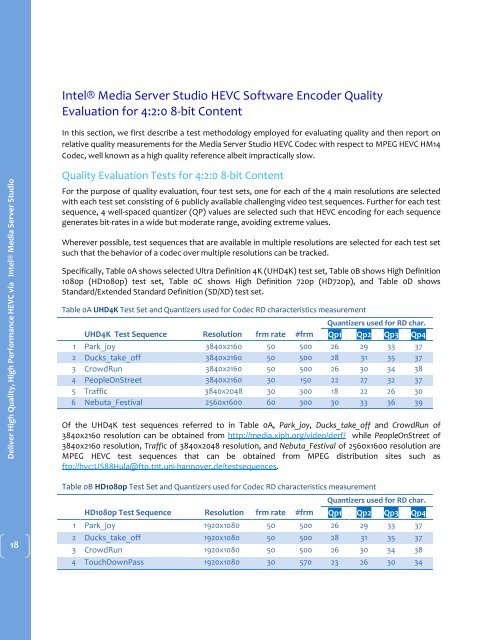Create successful ePaper yourself
Turn your PDF publications into a flip-book with our unique Google optimized e-Paper software.
<strong>Intel®</strong> <strong>Media</strong> <strong>Server</strong> <strong>Studio</strong> <strong>HEVC</strong> Software Encoder <strong>Quality</strong><br />
Evaluation for 4:2:0 8-bit Content<br />
In this section, we first describe a test methodology employed for evaluating quality and then report on<br />
relative quality measurements for the <strong>Media</strong> <strong>Server</strong> <strong>Studio</strong> <strong>HEVC</strong> Codec with respect to MPEG <strong>HEVC</strong> HM14<br />
Codec, well known as a high quality reference albeit impractically slow.<br />
<strong>Deliver</strong> <strong>High</strong> <strong>Quality</strong>, <strong>High</strong> <strong>Performance</strong> <strong>HEVC</strong> <strong>via</strong> <strong>Intel®</strong> <strong>Media</strong> <strong>Server</strong> <strong>Studio</strong><br />
<strong>Quality</strong> Evaluation Tests for 4:2:0 8-bit Content<br />
For the purpose of quality evaluation, four test sets, one for each of the 4 main resolutions are selected<br />
with each test set consisting of 6 publicly available challenging video test sequences. Further for each test<br />
sequence, 4 well-spaced quantizer (QP) values are selected such that <strong>HEVC</strong> encoding for each sequence<br />
generates bit-rates in a wide but moderate range, avoiding extreme values.<br />
Wherever possible, test sequences that are available in multiple resolutions are selected for each test set<br />
such that the behavior of a codec over multiple resolutions can be tracked.<br />
Specifically, Table 0A shows selected Ultra Definition 4K (UHD4K) test set, Table 0B shows <strong>High</strong> Definition<br />
1080p (HD1080p) test set, Table 0C shows <strong>High</strong> Definition 720p (HD720p), and Table 0D shows<br />
Standard/Extended Standard Definition (SD/XD) test set.<br />
Table 0A UHD4K Test Set and Quantizers used for Codec RD characteristics measurement<br />
Quantizers used for RD char.<br />
UHD4K Test Sequence Resolution frm rate #frm Qp1 Qp2 Qp3 Qp4<br />
1 Park_joy 3840x2160 50 500 26 29 33 37<br />
2 Ducks_take_off 3840x2160 50 500 28 31 35 37<br />
3 CrowdRun 3840x2160 50 500 26 30 34 38<br />
4 PeopleOnStreet 3840x2160 30 150 22 27 32 37<br />
5 Traffic 3840x2048 30 300 18 22 26 30<br />
6 Nebuta_Festival 2560x1600 60 300 30 33 36 39<br />
Of the UHD4K test sequences referred to in Table 0A, Park_joy, Ducks_take_off and CrowdRun of<br />
3840x2160 resolution can be obtained from http://media.xiph.org/video/derf/ while PeopleOnStreet of<br />
3840x2160 resolution, Traffic of 3840x2048 resolution, and Nebuta_Festival of 2560x1600 resolution are<br />
MPEG <strong>HEVC</strong> test sequences that can be obtained from MPEG distribution sites such as<br />
ftp://hvc:US88Hula@ftp.tnt.uni-hannover.de/testsequences.<br />
18<br />
Table 0B HD1080p Test Set and Quantizers used for Codec RD characteristics measurement<br />
Quantizers used for RD char.<br />
HD1080p Test Sequence Resolution frm rate #frm Qp1 Qp2 Qp3 Qp4<br />
1 Park_joy 1920x1080 50 500 26 29 33 37<br />
2 Ducks_take_off 1920x1080 50 500 28 31 35 37<br />
3 CrowdRun 1920x1080 50 500 26 30 34 38<br />
4 TouchDownPass 1920x1080 30 570 23 26 30 34


